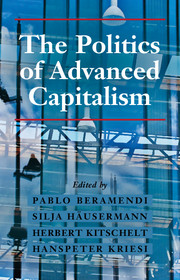Book contents
- Frontmatter
- Contents
- List of Figures
- List of Tables
- List of Contributors
- Preface
- 1 Introduction: The Politics of Advanced Capitalism
- PART I STRUCTURAL TRANSFORMATIONS
- 2 Prosperity and the Evolving Structure of Advanced Economies
- 3 The Origins of Dualism
- 4 Occupational Structure and Labor Market Change in Western Europe since 1990
- 5 Globalization, Labor Market Risks, and Class Cleavages Rafaela Dancygier and Stefanie Walter
- 6 The Return of the Family
- Part II Politics
- Part III Policies
- Part IV Outcomes
- Reference
- Index
3 - The Origins of Dualism
from PART I - STRUCTURAL TRANSFORMATIONS
Published online by Cambridge University Press: 05 May 2015
- Frontmatter
- Contents
- List of Figures
- List of Tables
- List of Contributors
- Preface
- 1 Introduction: The Politics of Advanced Capitalism
- PART I STRUCTURAL TRANSFORMATIONS
- 2 Prosperity and the Evolving Structure of Advanced Economies
- 3 The Origins of Dualism
- 4 Occupational Structure and Labor Market Change in Western Europe since 1990
- 5 Globalization, Labor Market Risks, and Class Cleavages Rafaela Dancygier and Stefanie Walter
- 6 The Return of the Family
- Part II Politics
- Part III Policies
- Part IV Outcomes
- Reference
- Index
Summary
From Spain and Greece to Brazil and South Africa, dualized labor markets are a worldwide phenomenon. In many countries, workers are divided between those with permanent contracts that include valuable benefits and extensive labor market protections and those who work under contingent contracts or no contracts at all. This latter group receives few or no labor market protections and lower levels of social benefits. They are the world's labor market outsiders. Recent research has suggested that this pool of outsiders has important implications for the nature of democratic politics in the twenty-first century, an argument that is perfectly in line with the core idea of this book, namely, that coalitional alignments among different labor market groups are at the heart of postindustrial reform strategies.
Yet the extent of dualization varies hugely across countries. Data on the size of the informal sector around the world (from Schneider et al. 2010) show that while there is clearly a negative association between the wealth of societies and the extent of dualization, there is also huge variation both within and across rich and developing nations. In the OECD context, the process of dualization has been linked to a number of political and economic processes: increasing competition in manufacturing, the rise of the service sector, the decline of unionization, political choices by Left governments, and others. Echoes of these arguments are present in work on developing countries, where dualization is closely linked to the informal sector and has received a lot of attention from economists and sociologists (if not political scientists). Indeed, a long tradition of models in development economics emphasize the stark income and productivity gaps inherent in “dual economies” and the uneven growth that characterizes broad swaths of the developing world (Rosenstein-Rodan 1943; Ray 2010). Yet while all of these arguments emphasize important features of dualization, they often focus on the consequences rather than the causes of labor market dualism.
- Type
- Chapter
- Information
- The Politics of Advanced Capitalism , pp. 89 - 111Publisher: Cambridge University PressPrint publication year: 2015
- 40
- Cited by

